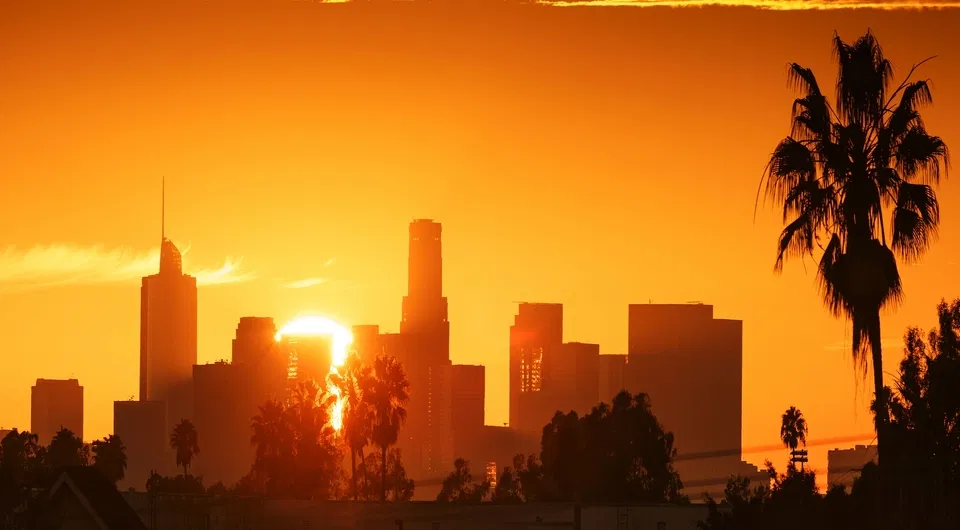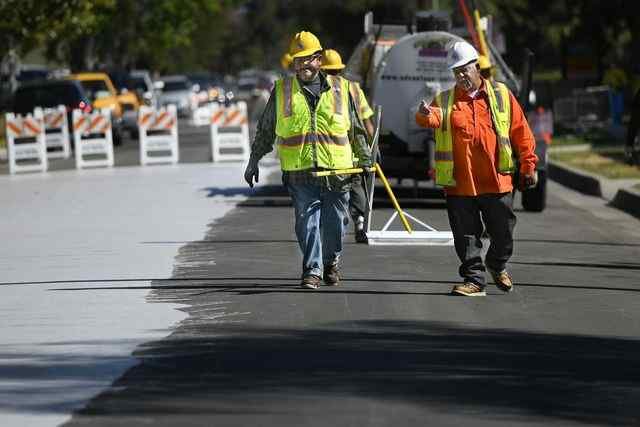
https://www.facebook.com/CanogaParkNeighborhoodCouncil/videos/1607791082567491/ The new street seal gushed from a downpipe Saturday onto Jordan Avenue, then spread like paint to turn a half block of black into a sea of gray. The morning temperature of the black asphalt in the middle of a nearby intersection read 93 degrees. The new light gray surface on Jordan Avenue read […]

https://www.facebook.com/CanogaParkNeighborhoodCouncil/videos/1607791082567491/
The new street seal gushed from a downpipe Saturday onto Jordan Avenue, then spread like paint to turn a half block of black into a sea of gray.
The morning temperature of the black asphalt in the middle of a nearby intersection read 93 degrees. The new light gray surface on Jordan Avenue read a cool 70 — on what would turn out to be the first heat wave of the year.
“It’s awesome. It’s very cool — both literally and figuratively,” exclaimed Councilman Bob Blumenfield, whose Los Angeles district includes Canoga Park, squinting into the laser handheld thermometer. “We are trying to control ‘the heat island effect’ ” — or hotter temperatures caused by urban sprawl.
“The downside: we won’t be able to fry eggs on the streets.”
Los Angeles, which had pioneered the use of compressed natural gas trash trucks and other vehicles, is now at the forefront of developing a “cool pavement” to lower temperatures along its thousands of miles of baking asphalt streets.
For the first time in the Golden State, it is testing a reflective street surface officials say could cut public road temperatures, cool the insides of nearby buildings, lessen air pollution and reduce the threat of deaths linked to increasingly hotter heat waves.
Before afternoon temperatures could push 100, city street workers spread a thin gray coating of CoolSeal into the heart of one of its hottest neighborhoods.
“The city’s going to get hotter because of climate change, particularly this neighborhood of the west San Fernando Valley,” said Greg Spotts, assistant director of the Bureau of Street Services, who doubles as its acting chief sustainability officer. “The phenomenon called the heat island effect means the city is hotter than the surrounding countryside.
“We’re exploring ways to reduce the heat island effect by reducing the absorption of heat in the built environment.”
Street Services, working in conjunction with GuardTop LLC, an asphalt coating manufacturer based in Dana Point, had first tested the cool pavement seal in the Sepulveda Basin.
Asphalt at a parking lot at the Balboa Sports Complex once averaged 160 degrees in summer. After the seal was applied two years ago, company officials say, surface temperatures dropped to between 135 to 140 degrees.
Now, after rigorous testing for durability and wet skid potential, the CoolSeal coating was being slathered across a half block of Jordan Avenue just north of Hart Street near the headwaters of the Los Angeles River.
If the new seal could boost solar reflectivity —and dramatically cool a street lined with two-story apartments in the hottest region of the San Fernando Valley — it could do it anywhere, city officials said.
The experiment will soon be duplicated in 14 other council districts before the end of June. If successful, city officials hope to encourage manufacturers to help develop cool pavement that could be incorporated into a multimillion-dollar drive to fix a backlog of L.A.’s failing streets.
“I’m thrilled to be here. This is a great day for all of us. We look forward to seeing what the results will be,” said Kevin James, president of the Los Angeles Board of Public Works.
A CoolSeal coating could cost an estimated $40,000 per mile and last seven years, city officials said. But that’s subject to change pending pavement innovation.
“We’re going to try to make Los Angeles as cool as possible,” said Jeff Luzar, national sales director for GuardTop, a privately owned firm that has covered coated mostly playgrounds and parking lots. “We’re going to be the coolest island in Southern California.”
Average temperatures in Los Angeles have risen 5 degrees in the past 100 years on account of the heat island effect produced by miles of asphalt freeways, roads, parking lots, roofs and more, climatologists say. In summer, temperatures have risen an average 10 degrees.
In addition, extreme heat days near 100 degrees have risen from two a year in 1906 to 24, while their duration has increased from a few days in a row to heat waves of two weeks, said climatologist Bill Patzert of the Jet Propulsion Laboratory.
“I’m all for it,” Patzert said of the cooler pavement. “We could certainly stop the rise — and perhaps reverse it.”
Unfortunately, he added, the urban forest across Los Angeles is dying because of insufficient watering during the recent drought. “They can paint the streets gray,” he said, “but when all these trees die, you’ll see a dramatic increase in the heat island effect in the whole Basin.”
The residents of Canoga Park were astonished, even thrilled, to see black asphalt turn a light shade of gray within 30 minutes.
“I think it’s awesome,” said Partha Ghosh, 30, who lives at an apartment at Jordan Avenue and Hart Street, staring at the battleship-like surface. “Not too bright. Just perfect.
“I hope it could cool off my apartment.”